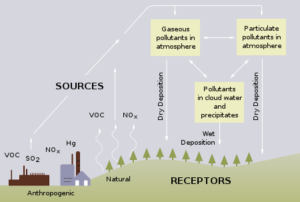You have to wonder why after two million years’ time, humans are still being exposed to and breathing bad air. It’s mind-boggling, if not more than a little disconcerting, to say the least.
Through document searches I look for hope, encouraging words.
Take, for instance, the following from the San Joaquin Valley Air Pollution Control District’s “2017-18 Report to the Community”:
“Looking back we can all be proud of the fact that air pollution in the San Joaquin Valley has been reduced by more than 85%. Most residents live in areas of the Valley which now meet the federal clean air standards, and even in our remaining hot spot areas residents experience more clean air days than ever before,” in the “A message from the Air Pollution Control Officer” part of the “2017-18 Report to the Community” as presented on what is referred to in the “Report” as the “Inside Page.”
And I’m encouraged.
Now, 85 percent is considerable, but over what period of time are we talking about here? If I understand correctly, this “more than 85%” improvement in Valley air quality has occurred over a period of 37 years. This is the duration that Seyed Sadredin, then Valley Air District Executive Director and Air Pollution Control Officer, had been in public service.
And, as to the reason or reasons that could explain the positive news, it appears that such improvement can be attributed to two factors: resident cooperation and regulatory compliance.
That would seem reasonable.
But, I would have to ask the questions: Why not 100 percent improvement? What’s missing?
Looking at one sector only – manufacturing, a University of California at Berkeley study finds that implementation of regulations was more effective at reducing pollution than would say voluntary steps taken to do the same?
In “Environmental regulations drove steep declines in U.S. factory pollution,” an Aug, 9, 2018 University of California at Berkeley Public Affairs press release so stated is: “The study, forthcoming in the American Economic Review, found that polluting emissions from U.S. manufacturing fell by 60 percent between 1990 and 2008—a period in which manufacturing output grew significantly—primarily because manufacturers adopted cleaner production methods in tandem with increasingly strict environmental regulation.
“‘In the 1960s and 1970s, people worried that Los Angeles, New York and other U.S. cities would have unbearable air pollution levels by the end of the 20th century,’ said Joseph Shapiro, an associate professor of agricultural and resource economics who coauthored the study with Reed Walker, an associate professor in the Haas School of Business and Department of Economics. ‘Instead, air pollution levels have plummeted, and the evidence shows that environmental regulation and the associated cleanup of production processes have played important roles in those steep declines,’” as cited in the UC Berkeley release.

“‘People often assume that manufacturing production pollutes less today because manufacturing output has declined, when in fact output was 30 percent greater in 2008 than in 1990,’ said Walker. “Others argue that manufacturing has shifted towards cleaner, high-tech products or that the manufacturing of “dirty” products like steel has moved to China, Mexico or other foreign countries. Our analysis showed that changes in the product-mix of U.S. manufacturing do not explain much of the reduction in emissions. Instead, manufacturers are producing the same types of goods, but they’ve taken significant steps to clean up their production processes.’”
However, the difference cannot alone be attributed to implementation of enhanced or improved manufacturing production processes.
Emphasizes UC Berkeley Public Affairs in the press release: “The researchers sought to identify the key driver of the change in production technology. They quantified the importance of reductions in tariffs and other trade costs, improved productivity and environmental regulation in explaining decreases in air pollution emissions. Then they showed that the stringency of environmental regulation for manufacturing firms nearly doubled between 1990 and 2008. The researchers demonstrate that this increase in regulatory stringency, rather than improvements in manufacturing productivity or trade exposure, accounted for most of the decreases in pollution emissions.”
So, there you have it.
Could this study have implications for other sectors such as transportation, power production, agriculture, etc.? Absolutely!
Related reading: “Best air pollution control: A carrot or stick approach?”
Image above: Wikimedia Commons
This post was last revised on Jun. 16, 2020 @ 6:12 a.m. Pacific Daylight Time.
– Alan Kandel
